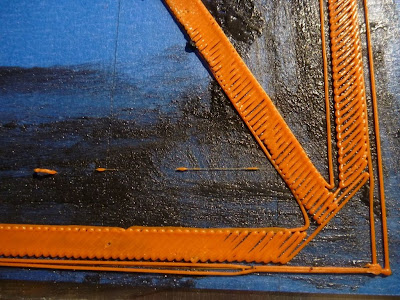The original WhiteAnt design utilizes 3/8" V-groove bearings for the Y-axis movement. It works by sliding a metal strap (that's attached to the side of the printer’s bed) in and along the V-groove of the bearings. The motor and belt system is located to the left of the bed.
This system may be fine for the original design, but has always been a concern for me since I increased the bed size from 8 9/16" x 9 1/16" to 12" x 17". Pulling the bed from one side with the V-groove bearing system creates wobble in the bed and there’s more vibration in the printer as a whole.
My solution to this problem has been to replace the entire bearing system with a different design. I'm using (2) 16mm linear shafts with 4 slide bearings which I mounted to the base of the printer. This eliminates any stress on the printer’s structure and it provides more precision in its movement.
I kept the motor and belt system as originally designed: it's a belt stretched across both ends of the Y-axis length of travel and powered by the motor’s pulley in the middle. Tension is created by 2 idler pulleys (made from bearings) pulling the belt around the motor’s pulley in a S-shaped curve.
Keeping this design was not a good idea. I don't have the optimum clearance for the belt and there is undue stress on the belt when the bed fully extends on its axis.
My first test print with this new setup ended with disaster. Not only am I still getting distortion in my print, but I lost Y-axis movement about half way through the print. Something must have snagged the belt and stretched it out of shape.
I decided to use a belt drive system similar to what is utilized on the Prusa Mendel 3d printer.
I fabricated a motor mount and an idler pulley tensioner system from Simpson Tie angle brackets. I ran the belt around the pulleys and attached the ends to the printer’s bed forming a large loop.
The second print test is better after the belt drive system change, but there is still some distortion. The infill doesn't cover completely across the print in areas, leaving an open space along the perimeter wall.
I tighten the belts and started a third print test. This time the distorted has cleared and the print seems flawless.
A lot of print distortion can clearly be the cause of poor axis alignment and obstruction. Probably the most common problems are caused by inadequate belt tension that causes backlash in the belt system.
I don't have a completed test print this time for one reason: warping. Once again, I have the problematic issue of controlling the curling ends of my large prints. I plan to tackle this more aggressively and show my results in my next entry.
This system may be fine for the original design, but has always been a concern for me since I increased the bed size from 8 9/16" x 9 1/16" to 12" x 17". Pulling the bed from one side with the V-groove bearing system creates wobble in the bed and there’s more vibration in the printer as a whole.
My solution to this problem has been to replace the entire bearing system with a different design. I'm using (2) 16mm linear shafts with 4 slide bearings which I mounted to the base of the printer. This eliminates any stress on the printer’s structure and it provides more precision in its movement.
I kept the motor and belt system as originally designed: it's a belt stretched across both ends of the Y-axis length of travel and powered by the motor’s pulley in the middle. Tension is created by 2 idler pulleys (made from bearings) pulling the belt around the motor’s pulley in a S-shaped curve.
Keeping this design was not a good idea. I don't have the optimum clearance for the belt and there is undue stress on the belt when the bed fully extends on its axis.
My first test print with this new setup ended with disaster. Not only am I still getting distortion in my print, but I lost Y-axis movement about half way through the print. Something must have snagged the belt and stretched it out of shape.
 |
| 1st print run. |
I decided to use a belt drive system similar to what is utilized on the Prusa Mendel 3d printer.
I fabricated a motor mount and an idler pulley tensioner system from Simpson Tie angle brackets. I ran the belt around the pulleys and attached the ends to the printer’s bed forming a large loop.
The second print test is better after the belt drive system change, but there is still some distortion. The infill doesn't cover completely across the print in areas, leaving an open space along the perimeter wall.
 |
| 2nd print run. |
 |
| 2nd print run. Wavy lines cause irregular perimeter surface. |
I tighten the belts and started a third print test. This time the distorted has cleared and the print seems flawless.
 |
| 3rd print run. A much better print. |
 |
| 3rd print run. |
A lot of print distortion can clearly be the cause of poor axis alignment and obstruction. Probably the most common problems are caused by inadequate belt tension that causes backlash in the belt system.
I don't have a completed test print this time for one reason: warping. Once again, I have the problematic issue of controlling the curling ends of my large prints. I plan to tackle this more aggressively and show my results in my next entry.







